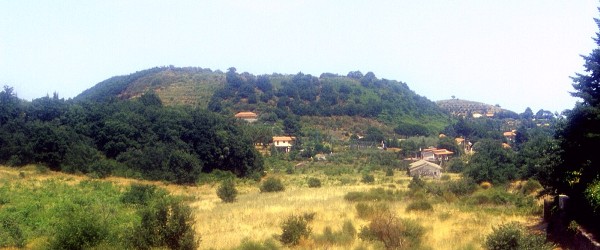| Etna
index |
||
| Geology | Geological history | Cones and craters |
| Eruptive characteristics | Eruptions before 1971 | Eruptions since 1971 |
| Etna and Man | References | Web sites |
| Weather forecasts | FAQ | Latest news |
Mamma
Etna's countless children
Tre Monti
SE flank, 15.065938° E, 37.636166° N (north cone);
15.062612° E, 37.634960° N (west cone); 15.066712° E, 37.632614°
N (SE cone)
Summit elevation: 755 m (north cone); 746 m (west cone); 725 m (SE cone)
![]()
Tre
Monti means "Three Mountains", and this peculiar cluster of
pyroclastic cones actually consists of three distinct small mountains
that lie in an area with numerous other larger and smaller flank cones
of Etna. They lie to the north of the town of Pedara and together occupy
an area of no more than 0.4 km2. In map view, they form a nearly
perfect triangle, with the largest cone lying to the north, the second
largest to the west, and the smallest to the southeast. Their summit height
varies by only 30 m, and when seen from many locations in different directions
they appear to be of equal proportions. Seen close-up, however, the Tre
Monti are seen to be different both in size and shape. They formed during
one or more undated prehistoric eruption(s) and grew a few tens of meters
around the surrounding terrain, with a maximum relative height of 90 m
(northern cone). The northern and western cones are highly symmetrical
and are truncated by the nearly horizontal rims of their craters, while
the southeastern cone has a high eastern crater rim; much of the crater
area of this latter cone is occupied by buildings and gardens belonging
to the "Villaggio Tre Monti". The northern cone has a well-preserved
crater about 20 m deep, while the southern summit area of the western
cone seems to have been modified by human activity - mostly bulldozing,
possibly aimed at extracting construction material.
Among Etna's flank cones the Tre Monti are surely not the most pleasant
and interesting to visit. They lie in a strongly urbanized area, and yet
the common practice of discharging waste in any spot that is not someone's
private property is widely evident. Volcanologically these three cones
do not offer anything outstandingly fascinating. The only reason to visit
them is to see the results of the savage and uncontrolled urbanization
on the southeastern flank of Etna, and enjoy some panoramic views.
I visited the Tre Monti in July 2003, when all photographs shown on this
page were taken.
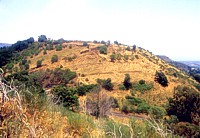 |
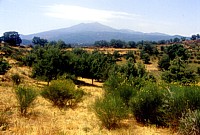 |
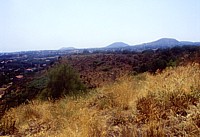 |
Left:
after many weeks without precipitation, dried vegetation gives the
northern cone of the Tre Monti an intense yellow color. This is
the tallest of the three cones in the cluster, and here it is seen
from the southern crater rim of the western cone, about 0.3 km away Center: this is the crater of the northern cone of the Tre Monti, showing the huge main edifice of Etna in the background Right: the remarkably flat south rim of the eastern cone is seen from the south rim of the neighboring northern cone, and in the background lie (from left to right) Mompilieri, Monti Rossi, and Mompeloso, near the town of Nicolosi and 3-5 km distant. Photos taken in early July 2003 |
||
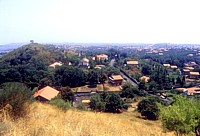 |
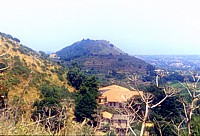 |
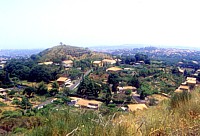 |
Left:
view from the southern crater rim of the northern cone onto the
southeastern cone, whose crater is largely occupied by homes and
gardens, named "Villaggio Tre Monti" Center: looking east from the western cone across the saddle between the northern and southeastern cones (marked by the large building in the lower center of image) toward a nameless low cone north of the town of Trecastagni and the symmetrical cone of Monte S. Nicolò in the background Right: the "Villaggio Tre Monti" and the eastern rim of the southeastern crater of the Tre Monti, seen here from the western cone, about 350 m distant. Photos taken in early July 2003 |
||
Copyright © Boris Behncke, "Italy's Volcanoes: The Cradle of Volcanology"
Page set up on 1 March 2004

